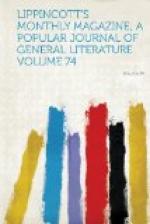ILLUSTRATIONS
The bridge across Lansdowne
ravine, connecting memorial and
horticultural halls.
Girard avenue bridge—one of
the approaches to the exhibition grounds.
Main building.
Machinery hall.
Hon. Joseph R. Hawley, president
of the Centennial commission.
General Alfred T. Goshorn, director-general
of the Centennial
commission.
John Welsh, ESQ., President of the Centennial
board of finance.
Agricultural building.
Horticultural hall.
Memorial hall, with extension.
Indigo-factory near Allahabad.
Mussulman school at Allahabad.
Malers and Sontals.
Grain-and-flour merchant of Patna.
A tiger-hunt, elephant-back.
Bengal water-carriers.
BRAHMANS of Bengal.
BENGALESE of low caste.
Chariot of the procession of the Rattjattra,
at Jaghernath.
The port of Calcutta.
LIPPINCOTT’S MAGAZINE
OF
POPULAR LITERATURE AND SCIENCE.
April, 1876.
Vol. XVII, No. 100.
THE CENTURY ITS FRUITS AND ITS FESTIVAL.
IV.—THE CENTENNIAL EXPOSITION UNDER ROOF.
[Illustration: The bridge across Lansdowne ravine, connecting memorial and horticultural halls.]
None of the European exhibitions we have sketched partook of the nature of an anniversary or was designed to commemorate an historical event. Some idea of celebrating the close of the calendar half-century may have helped to determine the choice of 1851 as the year for holding the first London fair; but if so, it was only with reference to the general progress during this period, and not to any notable fact at its commencement. Still less did the later exhibitions owe any portion of their significance and interest to their connection with a date. They afforded occasion for comparison and rivalry, but no shape loomed up out of the past claiming to preside over the festival, to have its toils and achievements remembered, and to be credited with a share in the production of the harvests garnered by its successors.
In our case it is very different. Here was the birth-year of the Union coming apace. It forced itself upon our contemplation. It appealed not merely to the average passion of grown-up boys for hurrahs, gun-firing, bell-ringing, and rockets sulphureous and oratorical. It addressed us in a much more sober tone and assumed a far more didactic aspect. Looking from its throne of clouds o’er half the (New) World—and indeed, as we have shown, constructively over the Old as well—it summoned us to the wholesome moral exercise of pausing a moment in our rapid career to revert to first principles,




